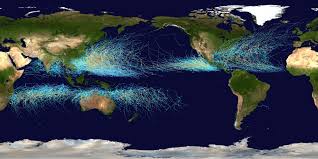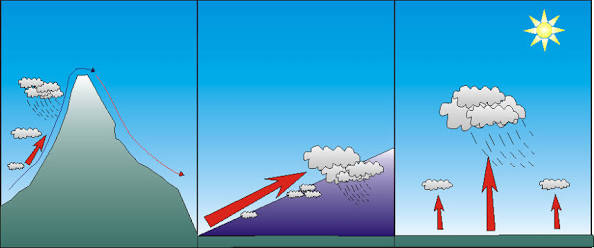Rainfall and Precipitation.
.jpeg)
wikipedia, United States tropical cyclone rainfall climatology
Hello fellow steemians!
Is always good to be here. I want to thank everyone who find time to read my articles, support me and give me feedback.
Special thanks to the #steemstem and #steemng community for giving me the opportunity to share my articles. Today, I will take you on the topic "Rainfall and precipitation ".
Rainfall
Rainfall occurs whenever moisture laden air masses rises, expand cools, coalesces, condenses and saturates at the atmosphere and latter fall back to the earth's surface as rain.
Rainfall occurs whenever :
- There is excessive land heating that generates warm air masses.
- When the warm air masses rise over a relief or mountainous barriers.
- When the cold air masses over power the warm air masses.
These air masses must rise to a given height at the atmosphere before they cool, expands, condense and saturates and later they fall down as rainfall. Rain drops are formed when small particles in the air mix with water vapour to form larger particles after expansion. It then cools and condenses into large mass of water droplets before it falls on the ground surface.
Precipitation
.jpeg)
wikimedia, Precipitation by type
Precipitation is any form of rain that falls on the ground surface. Precipitation includes drizzle, hail, haze, fog, mist, rainfall and snow which fall on the ground surface at any particular time and place on the world map.
Forms of Precipitation
Drizzle: They are the rains that occur in many small fine drops
Hail: Hail is a form of precipitation with extreme instability. It falls from lofty cumulonimbus clouds particularly when there is a passage of a cold front or after an exceptional local heating and convectional overturning. Soft hail is formed as a small spherical grains formed by aggregates of tiny ice particle, deposited by directed freezing from water vapour. Soft hail is white and opaque in character.
Haze: Haze is formed due to dust and smoke particles that are used during condensation process. It attracts impaired visibility of between one and two kilometers.
Fog: Fog occurs when there is condensation which results to the visibility being less than 1km. There are five types of fog viz; Radiation, advection, frontal, steam and hill of fogs.
Mist: is a form of condensation that occurs when the visibility is less than 2km.
Sleet: This is a mixture of snow and rain or partially melted snow and raindrops which have been frozen and partially melted again.
Snow: This is the frozen vapour falling from the sky in soft white flakes. The mass of these flakes cover the ground surface.
Dew: Dew occurs when condensation takes place on the surface of the particles which have been cooled by nocturnal radiation to a temperature below the dew point.
Rainfall Terminologies
Rainfall Event.
Rainfall Depth.
Rainfall Days.
Rainfall Event: Rainfall event is the actual time in the day or night the rainfall occurs which means a rainfall event is said to have occurred when the rain started at a particular time and ended at another stated time.
Rainfall Depth: Rainfall depth is the actual depth of rainfall in millimeter or centimeter collected during a given rainfall event.
Rainfall Days: Theses are the number of days in a month when rainfall events occurred.
Types of Rainfall
.jpeg)
wikimedia, Rainfall three types
There are three basic types of rainfall. They are :
- Conventional Rainfall.
- Orographic or Relief Rainfall.
- Cyclonic or Frontal Rainfall.
Conventional Rainfall
Conventional rainfall occurs in an area with intense heating during the day which causes an uprising of the warm air masses. These warm air masses mix with moisture laden vapour that rises, cools, condenses, expands, saturates and eventually fall back to the earth's surface as rain. This type of rainfall usually occurs in the afternoon accompanied with thunder and lightening.
Orographic or Relief Rainfall
This type of rainfall occurs when the air masses and the moisture laden, vapour are forced to ascend a mountain barrier and as it rises, the mix expands, cools, condense and saturates and later fall due to the topography of the land hence the movement of the air masses and water vapour at the windward side of the mountain which attracts much rainfall. The other side of the mountain where the winds descend is called the heeward or shadow side and there is little or no rainfall at this side.
Cyclonic or Frontal rainfall
This type of rainfall occurs as a result of the converging of two opposing air masses particularly when the equatorial air masses (warm air masses) meets the polar cold winds (cold air masses) .The warm air masses being lighter rises over the cold air masses that is denser and close to the land. On ascent both air masses expand, cool, condense and saturate and latter fall back as light rain or shower.
Characteristics of Rainfall
.png)
pixabay, Rain-cloud-nature-weather-sky
There are different patterns of rainfall. They include the following :
Local Rainfall.
Area Variability of Rainfall.
Spatial Distribution of Rainfall.
Dry Season Rain.
Local Rainfall: Local rainfall is a rainfall event that occurred and affected a limited area within a short period of time. It can occur due to the occurrence of stationary front or when the air masses could not get saturated and condensed into the cloud.
Area variability of Rainfall: This occurs when two or more places located within the same climatic zone receive different depths of rainfall in a rainfall event. It may occur due to the unequal heating of the land, quantity and time distribution of rainfall,the type of precipitation that occur.
Spatial Distribution of Rainfall: The rainfall is said to be spatially distributed if two or more places that belong to the same climatic zone receive unequal number of rainfall events or rainfall days in a particular season.
Dry Season Rain: Dry season rain occurs during the peak season of the year. It occurs as a result the unusual meeting of the north east trade winds and the south west trade winds. It can also result due to inter tropical discontinuity of the prevailing air masses. Dry season rain is common in tropics particularly in the months of December, January and February.
Reference
If you write STEM (Science, Technology, Engineering, and Mathematics) related posts, consider joining #steemSTEM on steemit chat or discord here. If you are from Nigeria, you may want to include the #stemng tag in your post. You can visit this blog by @stemng for more details. You can also check this blog post by @steemstem here and this guidelines here for help on how to be a member of @steemstem.

I live in Antalya in Turkey. I mean, I live on the Mediterranean coast. Here rainfall, orographic and frontal rainfall features. Apart from the summer season, the sea temperature in the Mediterranean is higher than the air temperature. So the rising air strikes the mountains and creates precipitation. The orographic depressions that take place in the Gulf of Genoa bring rainfall in autumn and winter.
For Example
image
Oh my goodness! So flooded. Are there no drainage systems?
There is but a lot of rain. Drainage system is not enough. :(
Ok.
As a follower of @followforupvotes this post has been randomly selected and upvoted! Enjoy your upvote and have a great day!
Thank you!
Quite enlightening. Thanks for the taking time to research and share this. Well-done.
Welcome.
Wow this is really educative
Beast post i like it
good write up but your images seem not to be from free sources.
They are. You can check.